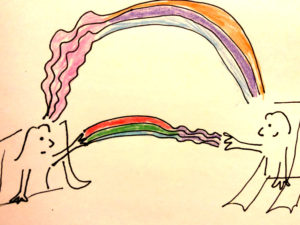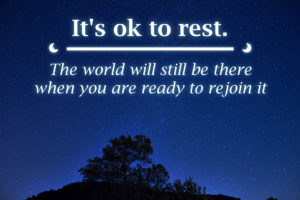Written by Alison Mee. Artwork by Heather Livingston and Sarah M.
By now you have probably realized, many times over, that you need to calm down. We all do. Our stress reactions can have lasting consequences for ourselves, our children and our society. We want to help keep our behavior productive. There are a lot of prepared fact sheets about mental health hygiene during this time.
But have you seen the imagery that these fact sheets tend to include? Some images are actually stress-inducing: stern-looking doctors in masks, upset people frowning. Some are more neutral, like an open laptop with the hand of a person typing on it. Some have no pictures — just long, long lists of all the things we should be doing.
The process of looking for information can be scary. Mixed in with our information, we need to see some sweetness. Spirals, leaves, a pleasant face, a book, a heart, a cup of tea. We need good, sound mental health and prevention advice, but we also need a gentle path toward it.
This project will allow you to quiet yourself. By sharing the project itself or the results of the project, you will help others improve their self-care. Many people are feeling the challenge of being away from their normal routine, away from friends and their usual comforts. We all need reminders of ways to cope.
Let’s make and share beautiful art around mental health tips, pertaining to what’s going on now with the social distancing, quarantine, and other challenges of this pandemic. We do want people to read the fact sheets for themselves, but we also want them to begin to feel calmer as soon as possible.
I gently encourage the following activity, which is good for kids, teens, and adults.
Here are the instructions:
First, center yourself. Think of something lovely. Find something beautiful right here in this moment. Enjoy the process of gathering some art supplies. Even old crayons can be mindfully presented. Even if you are by yourself right now, set the table for your project with care.
Then read through the stress reduction mental health tips. Some links are provided below. You can create a printed-out fact sheet (great for off-line reading). If you prefer, copy some of the ideas on to individual slips of paper to place on the table for yourself and other participants.
Think about yourself and the people around you. What is one tip that feels important for you to engage with? Or, what is something that seems important for your community to remember right now?
Start engaging with these words and this idea. Perhaps copy the words over, writing them in pencil, ink or paint – or playing with fonts, colors or public domain images in digital art. Maybe one or two of the words convey the basic idea. What if people see a beautiful image that says, “Remember to rest” and has fairies napping? “Try to eat balanced meals” and a gorgeous pencil sketch of a bowl of soup. Think cozy, beautiful, restful and caring.
Find your gladness and your wisdom. Breathe into it. Pour it into the art. Make a bit of art that fits with the mental health reminder you have chosen.
Then share. Share with your family, share with your friends. Share in whatever online platform you use. Anywhere you can share images. If your art has few or no words you can post it with a second message to your friends, like “I love you and want you to remember to go for a walk” and then your artwork of a person walking next to a tree. You can include a link to the online mental health fact sheet that you got your idea from, so other people can choose to get the tips they personally most need.

For this project, I encourage sharing very gentle messages. We have a lot of urgent informative messages, but we need some softness too.
There are many resources available, in addition to those listed below. These fact sheets include lists of ways to help yourself and your loved ones stay mentally healthy. Teens and adults can use one of these as a guide.
Coping with Stress During Infectious Disease Outbreaks, from SAMHSA (also available in Spanish)
Here is a collection of Resources to Support Mental Health and Coping with the Coronavirus (COVID-19), from SPRC
Some publications are specifically aimed at the professional helpers. You can use this project to cheer them on in their work. Find this specialized advice here: Sustaining Well-Being for Healthcare Personnel, from CSTS.
Please go gently with all this material. You personally may not be able to follow all the guidance right away. You may want to read these over with a family member.

It’s completely reasonable to have a lot of hard emotions right now. At the same time, we all wish to be at our best. We can really encourage peace and love and calm with this project. Do it gently though, because nobody needs to be perfect.
Please look at the accompanying art as a sample. While we are helping others, we will help ourselves, too. Relax and enjoy yourself as you work on this project. Please share this article, and your art.
Be kind with each other.